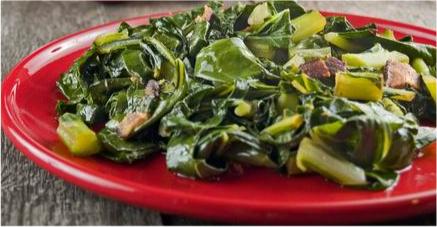If you’ve had enough White Christmas, or perhaps Red Christmas from blowing your budget, your luck is about to change. Now you can look forward to a Green New Year.
While across the globe, an economic crisis has put a damper on spirits and bank accounts, there is a glimmer of hope this New Year, and it’s called collard greens.
A traditional New Year’s dish in the Southern United States, collard greens are believed to bring a year’s worth of good fortune when eaten on the first day of the year. And while the borders are still open to free trade, this is one more custom I am going to borrow from my American cousins.
These large leafy vegetables, resembling green-back dollars, are one of the oldest members of the cabbage family, dating back to ancient Greece. And trying to get my hands on a bundle was more difficult than scoring a sold-out Star Wars Light Sabre.
I called every grocery store and specialty produce market in the book, inquiring about these lucky leaves. Most people I spoke with had no idea what I was even talking about, with comments ranging from the ridiculous, “Coloured greens? What colour are you looking for?” to the sublime, “Cull our greens? Yes, we only put out the freshest ones.”
Nothing creates desire quite like scarcity. The more unavailable they were, the more valuable they became.
I decided to brave the icy roads and bitter cold, to find me some collard greens. While on the way to a popular big box grocer, I took a detour to Choices Markets, a place I’d heard of, but never been. Well, not only did they know what collard greens were, they were getting a shipment in the next morning. So there I was, the next day, picking organic collards from the shelf when the produce manager commented, “I had a feeling someone would be looking for collard greens this year.” She must have the gift of prophecy to know of my desperate search for the elusive collard.
At $2.98 a bunch, they were a tad more expensive than other greens, but as they say, “you gotta spend money to make money.”
Although it’s not recommended to eat collards raw, due to their strong flavour and bitter aftertaste, I admit I enjoyed a crunchy nibble here and there. Simmering for about an hour will take the bite out of the bitterness. While Southerners boil their collards with ham hocks, I decided to forgo the ham for onions and a pinch of salt.
While my husband complained about the smell of cooking collards, I found they were not nearly as pungent as broccoli or cabbage, which makes everything, including the kitchen, stink.
Once they were done, I added a splash of Balsamic vinegar and a drizzle of extra virgin olive oil. This can be presented as a side dish to accompany a hot meal or chilled and served as a salad. Either warm or cold, this combination is delicious. Milder than cabbage or kale, collards can also be added to soups, stews and pasta dishes.
Not only are they rich in flavour, collards are packed with nutrients and antioxidants, containing vitamins A, C and E, iron, ascorbic acid, calcium, fibre and beta-carotene.
They keep for about a week in the refrigerator. Or you can blanche them and freeze for several months.
The greens are reportedly easy to grow, and are most widely cultivated in California, the southern U.S., and this coming summer, my garden. I’ve already adjusted my plot diagram to accommodate a whole row.
Collard greens in the garden could well be the next best thing to having a money tree in the backyard. And to finally find them feels like winning the lottery.
Have a safe, happy and prosperous New Year!

